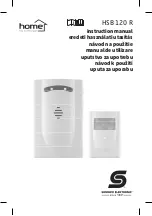
DS80IR1F-001C
7
<NOTE>
While replacing the batteries, after having removed the flat batteries, press the micro tamper button twice to
discharge the device completely before inserting the new batteries.
Preparation
Extract the battery isolator to activate the battery,
The LED will blink for 30 seconds (the detector is being initialised). During initialisation, the detector will not be activated.
It is advisable not to generate any alarms during this time. Once the initialisation time has finished, the LED will switch
off and the detector is ready to start working.
Enable the control unit to run the device learning procedure. Refer to the control unit instruction manual for details.
Open the casing and press the Test button.
Refer to the instruction manual of the control unit to complete the learning process.
After having integrated the detector, set the control unit to “
Walk Test
” mode: keep the detector in the required position
and press the Test button to confirm that the concerned position is within the communication range of the control unit;
see the control unit instruction manual to complete the Walk Test.
Proceed with the installation after having ascertained that the detector is working in the desired position.
Infrared detection coverage
When it is mounted in vertical position, the detector has a frontal detection coverage range of 10° on the horizontal plane
and of 110° on the vertical plane.
The detector is only activated by movements in the 10° horizontal coverage area.
The detector may be mounted vertically or horizontally on the surface of the wall or to the ceiling. Different installation
methods from that described imply different detection coverages (see further details in the next paragraph).
Mounting method
The detector was designed to be mounted on a flat
surface, on a wall or in a corner using the fixing screws
and the anchor bolts provided.
If the detector is forcefully removed from the surface on
which it is installed, the tamper switch pre-cut area will
detach from the detector remaining attached to the
surface and the detector will generate an alarm.
Hole arrangements are provided on the base where the
plastic is thinner and may be broken.
I. Release the cover from the base levering with a
slot screwdriver in the housing provided for the purpose.
II. Perforate the appropriate hole arrangements on the inner side of the base.
III. Using the bases as template, make the holes in the surface.
IV. Insert the anchor bolts if the device is fixed to plaster or bricks.
V. Screw the base into the anchor bolts.
VI. Reposition the cover on the base inserting the upper coupling of the cover in the specific slot provided on the
base first.
The detector may be installed either vertically or horizontally or onto the ceiling. Each method implies different applications,
illustrated below.
Vertical wall mounting:
The detector is designed to cover an 8 metre curtain area when it is installed from 1.4 to 1.7 metres from the ground.
Avoid mounting over 1.8 metres high because this could compromise the correct functionality of the detector.
Horizontal wall mounting:
When mounted horizontally, the detector has a detection coverage of 5 metres and only for vertical movements. It
cannot detect horizontal movements. This feature is only useful for detecting intrusions in case of access from the
top, e.g. by means of skylights or hatches on the roof.
Avoid mounting under 2.2 metres high because this could compromise the correct functionality of the detector.
Pre-cut area for
tamper switch
Hole
arrangement
for fixing on
surface x 2
8m


































